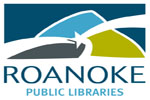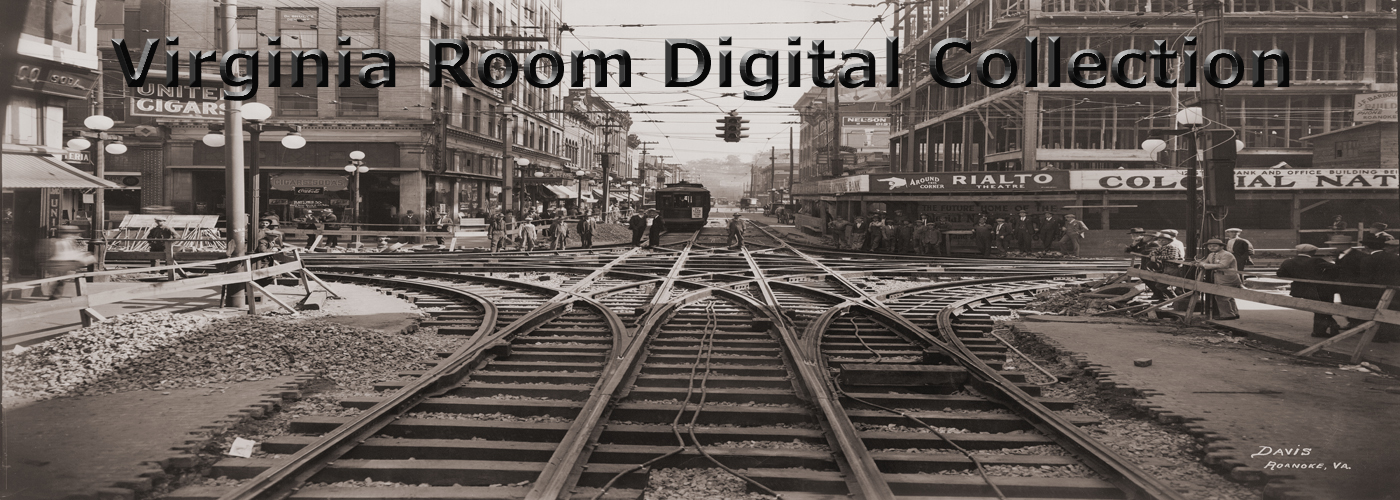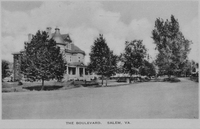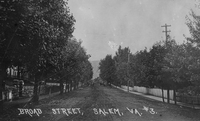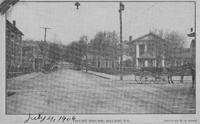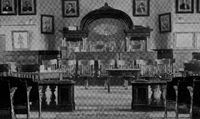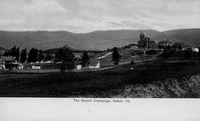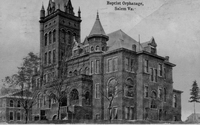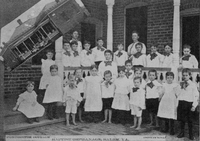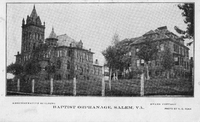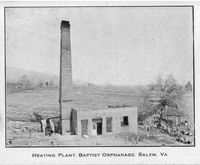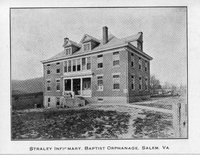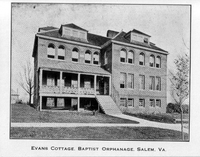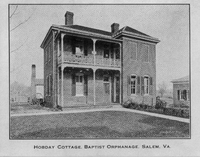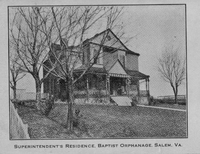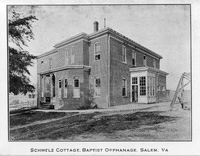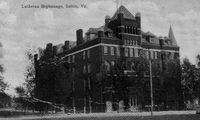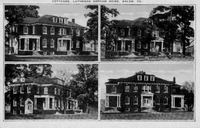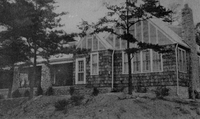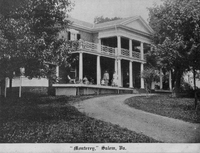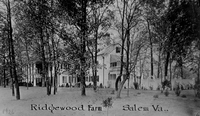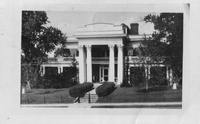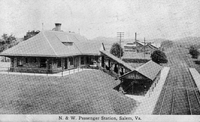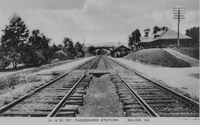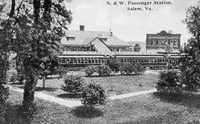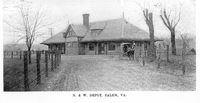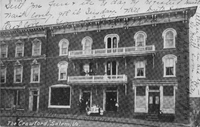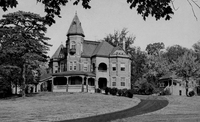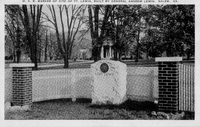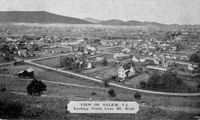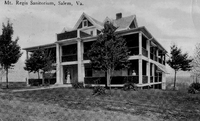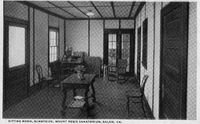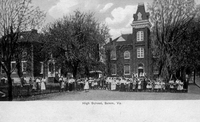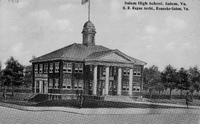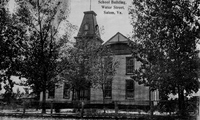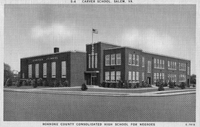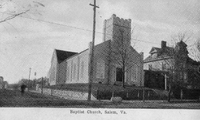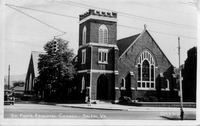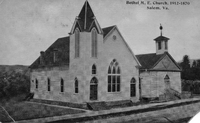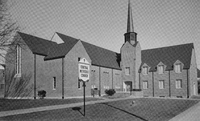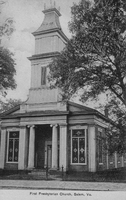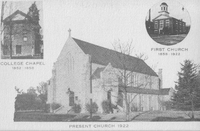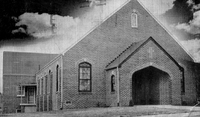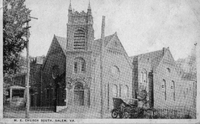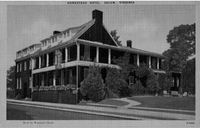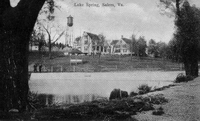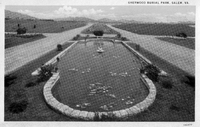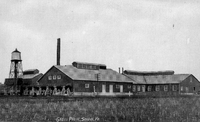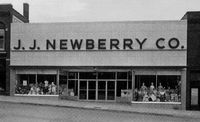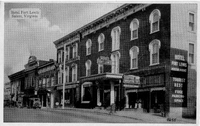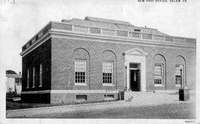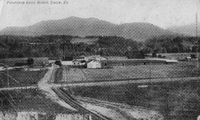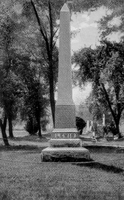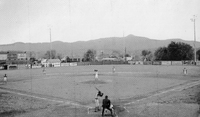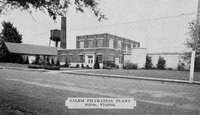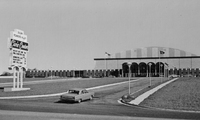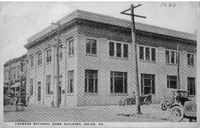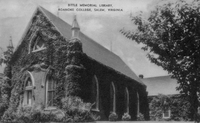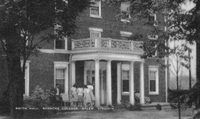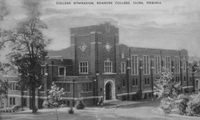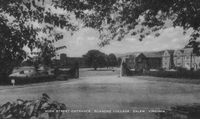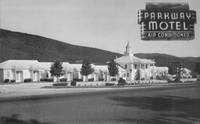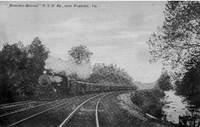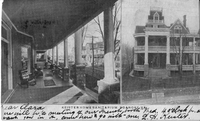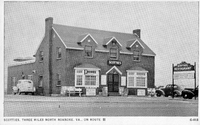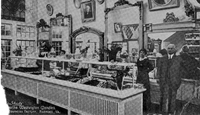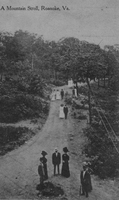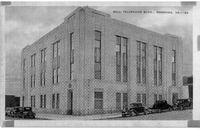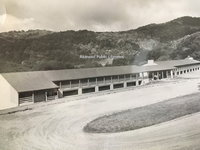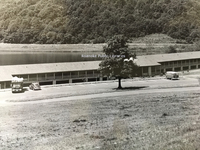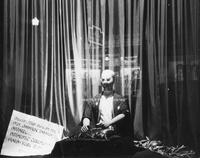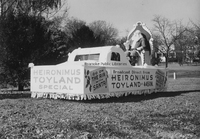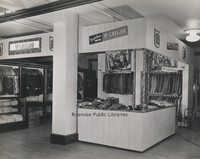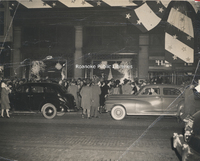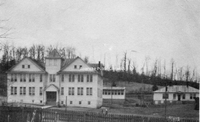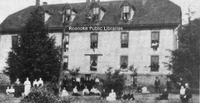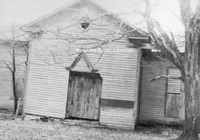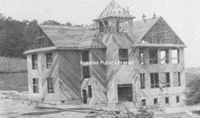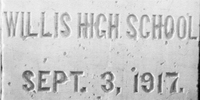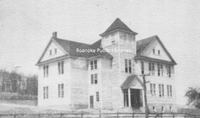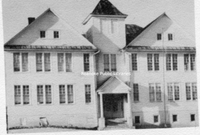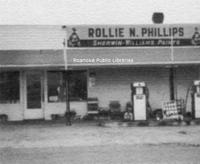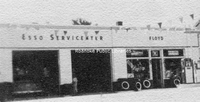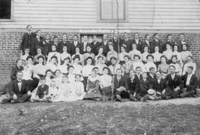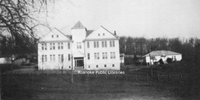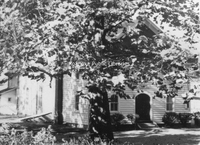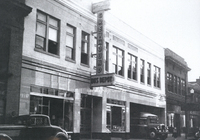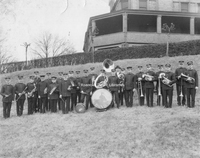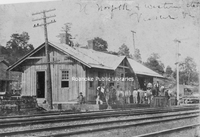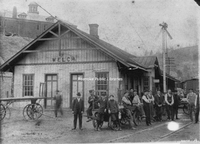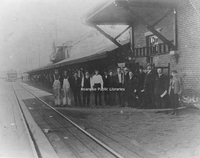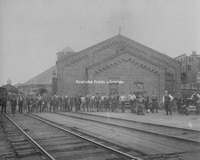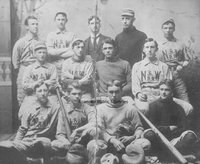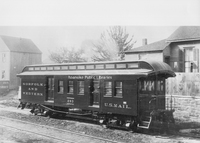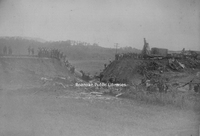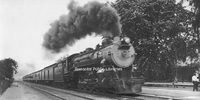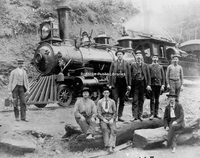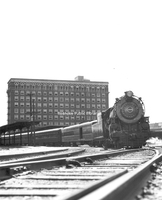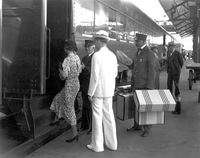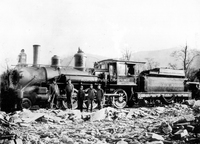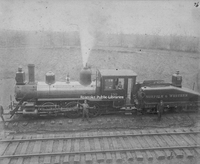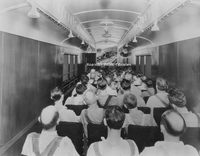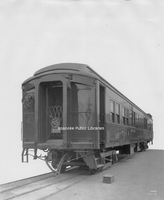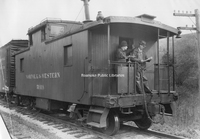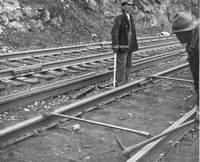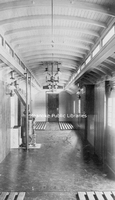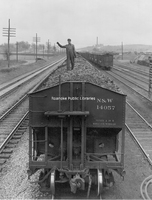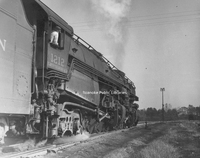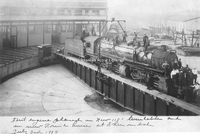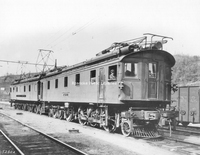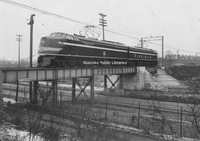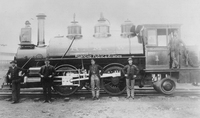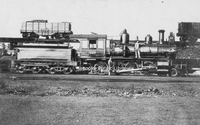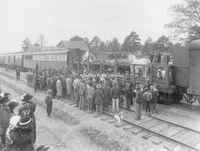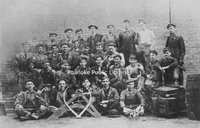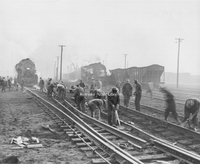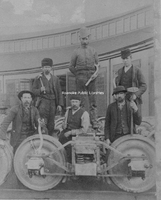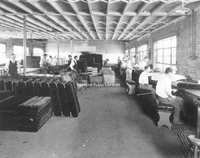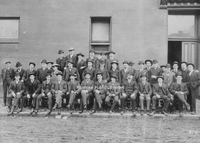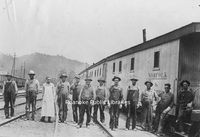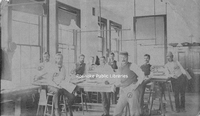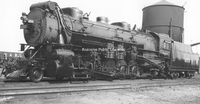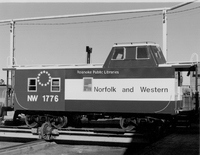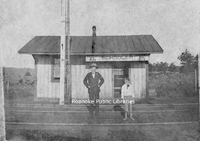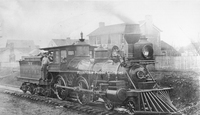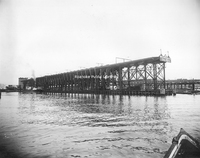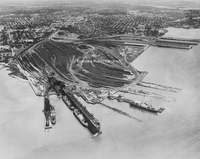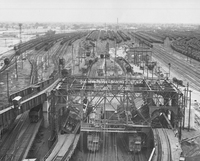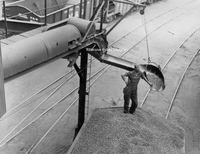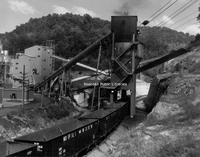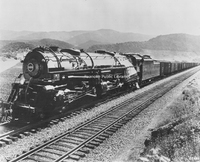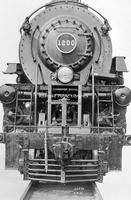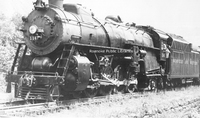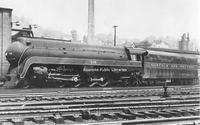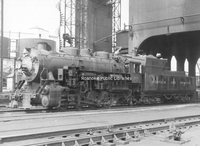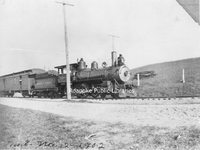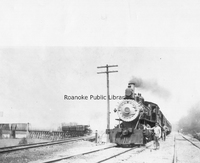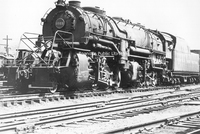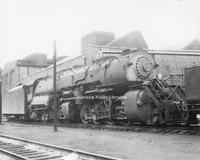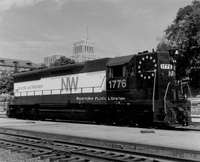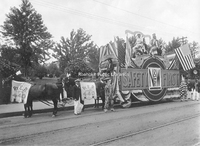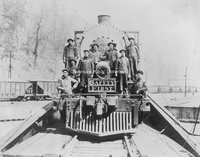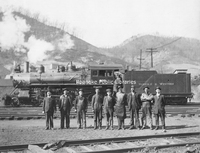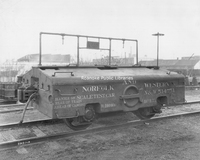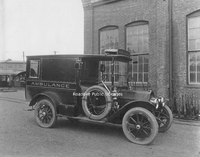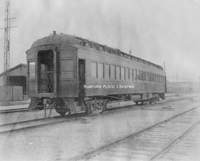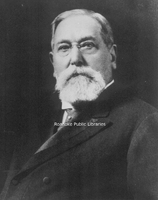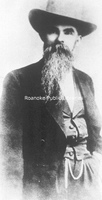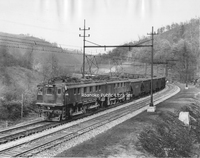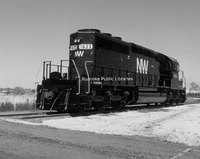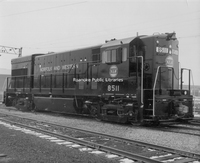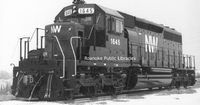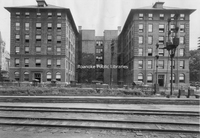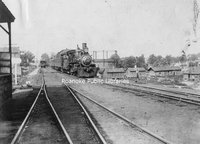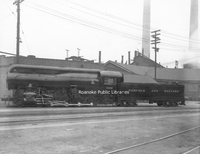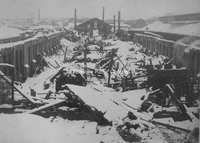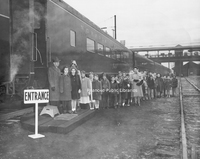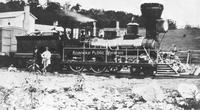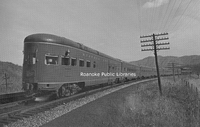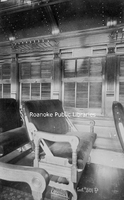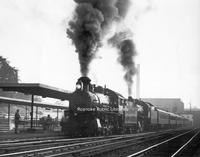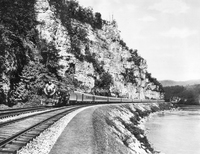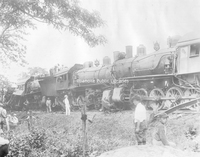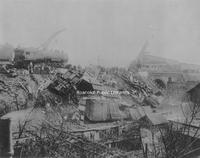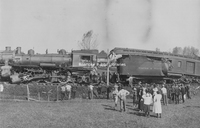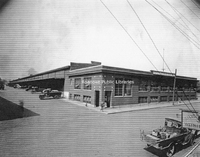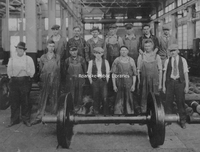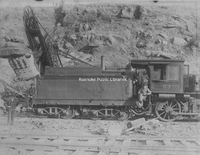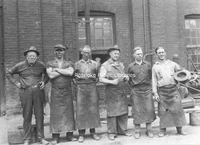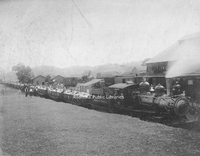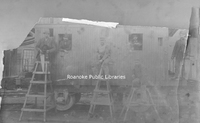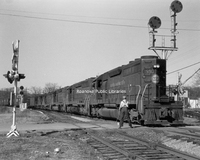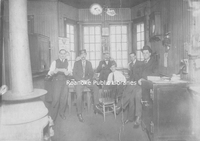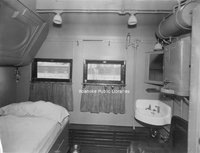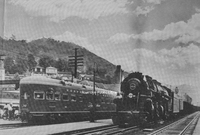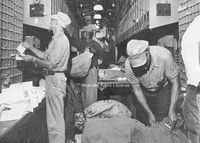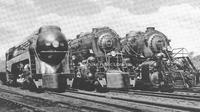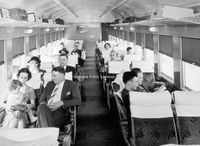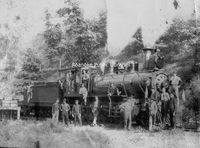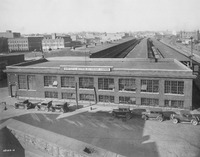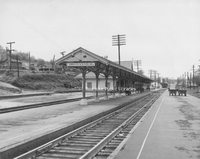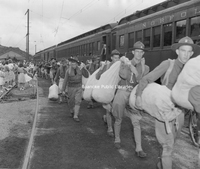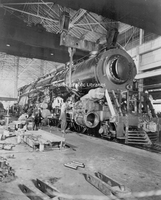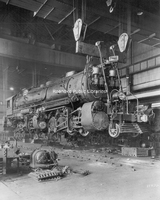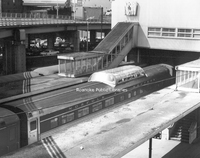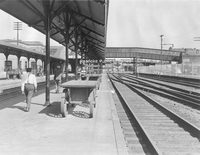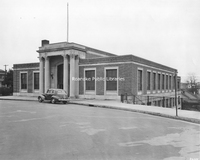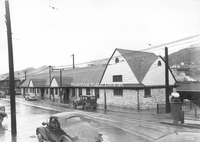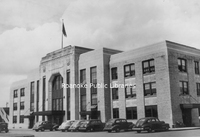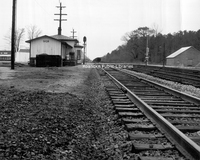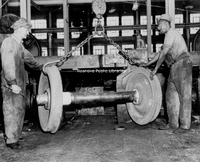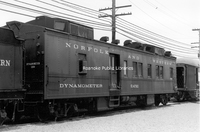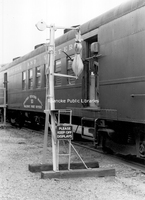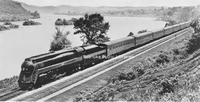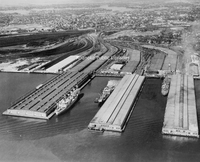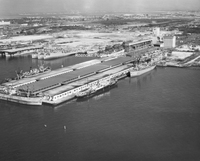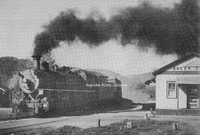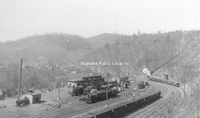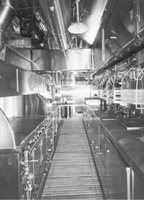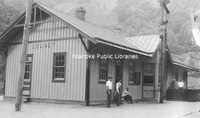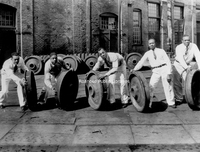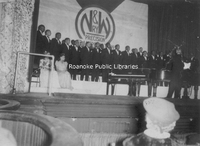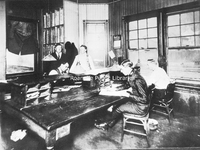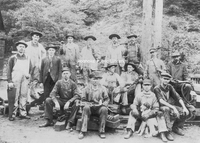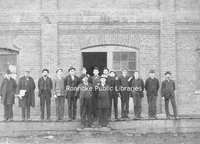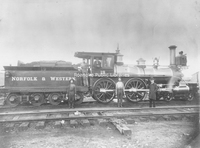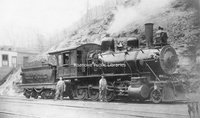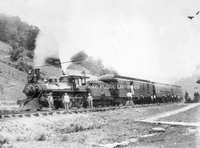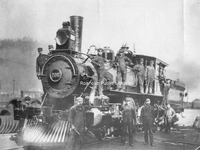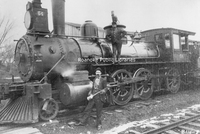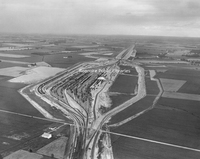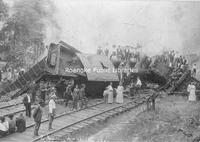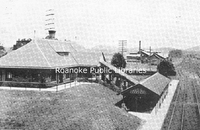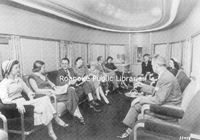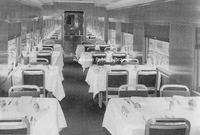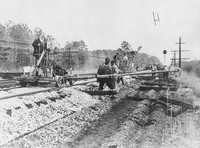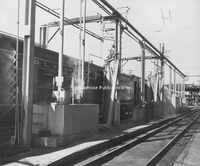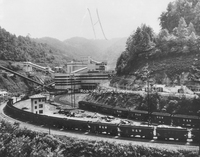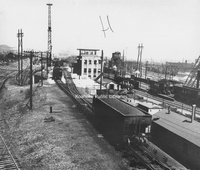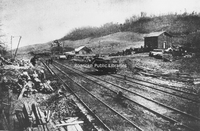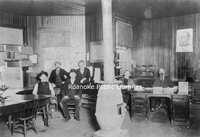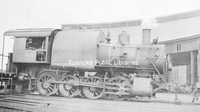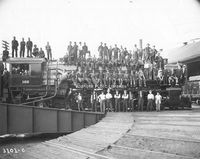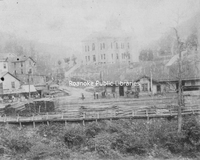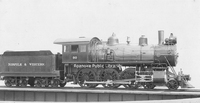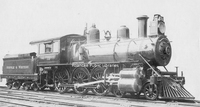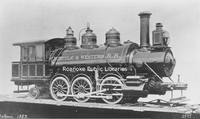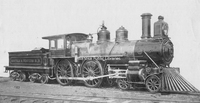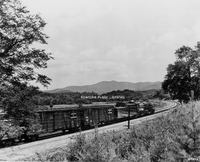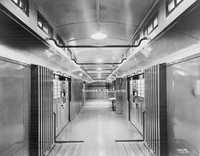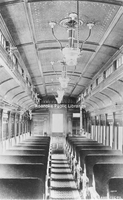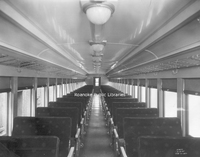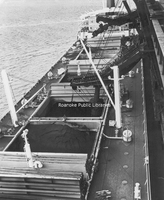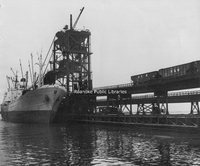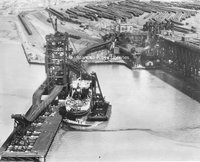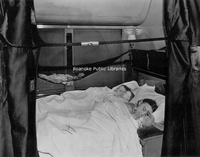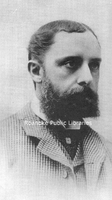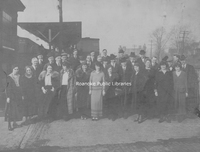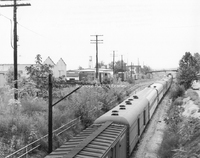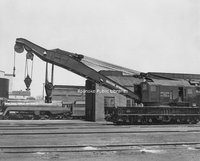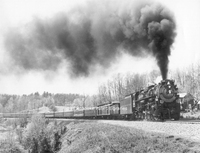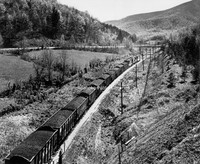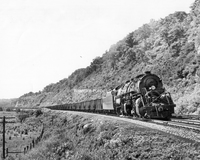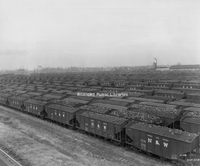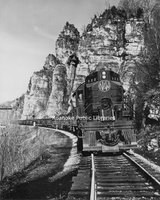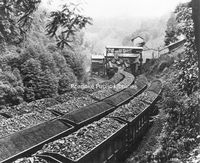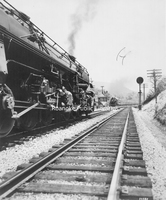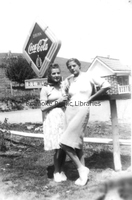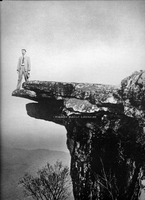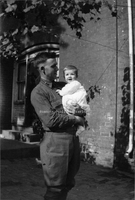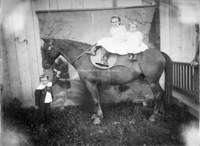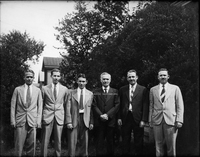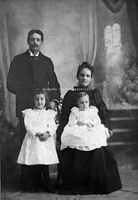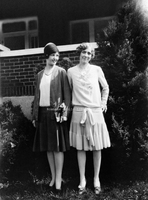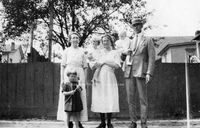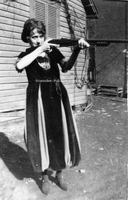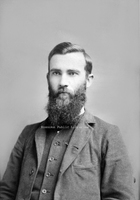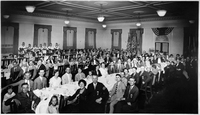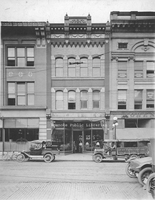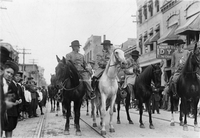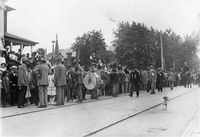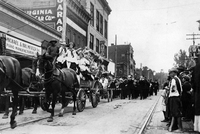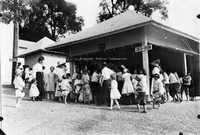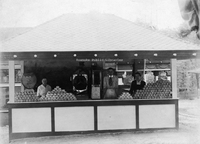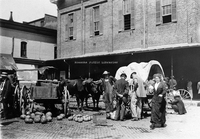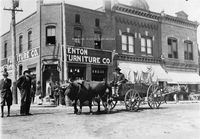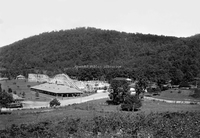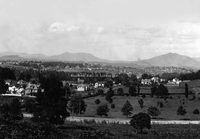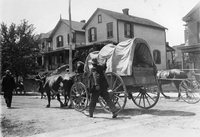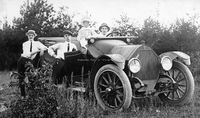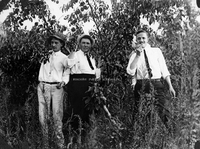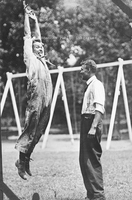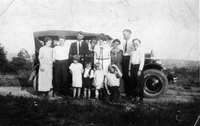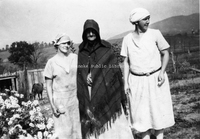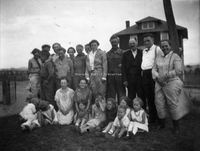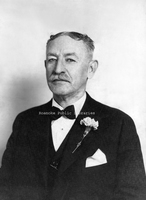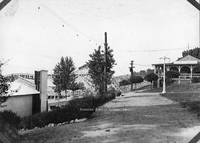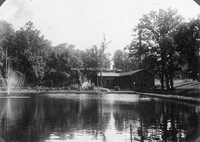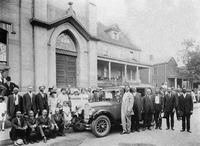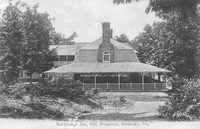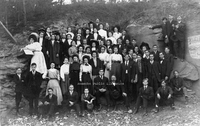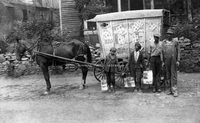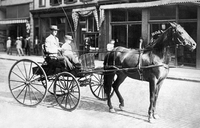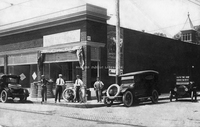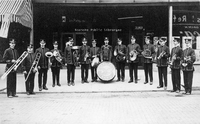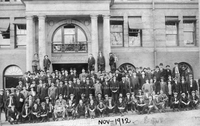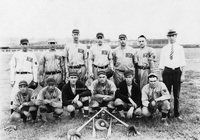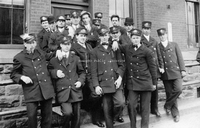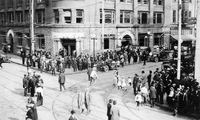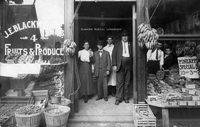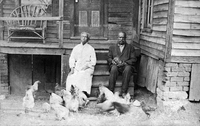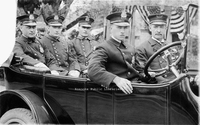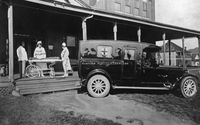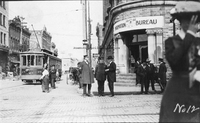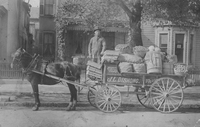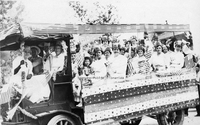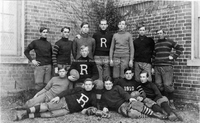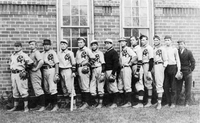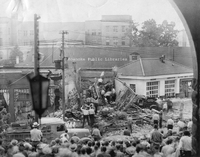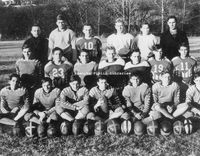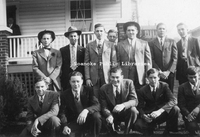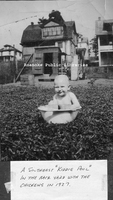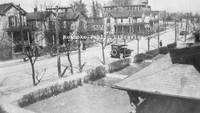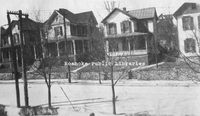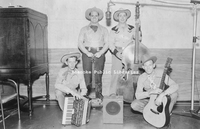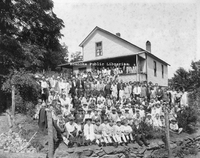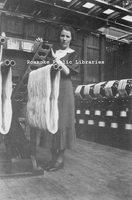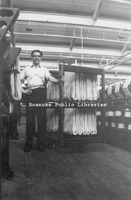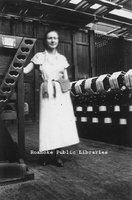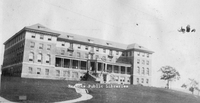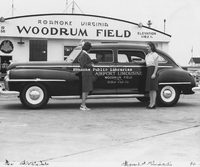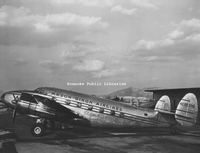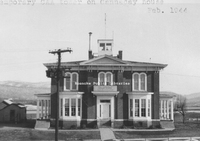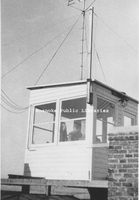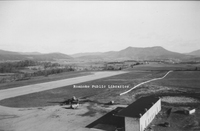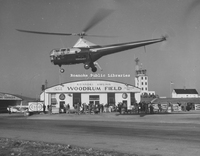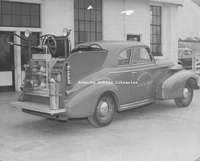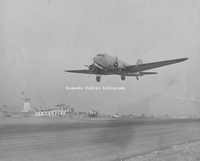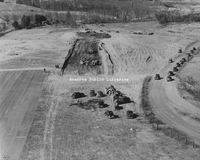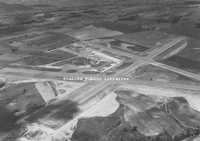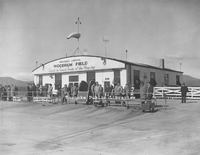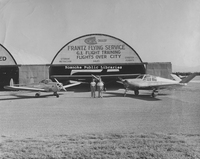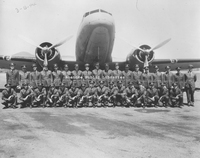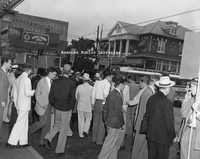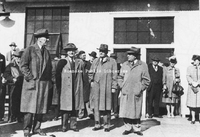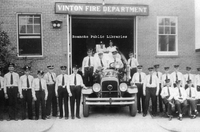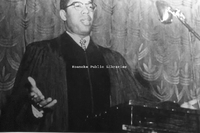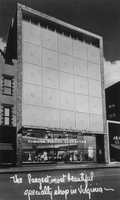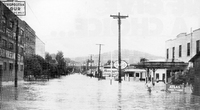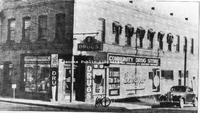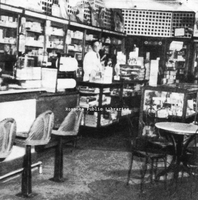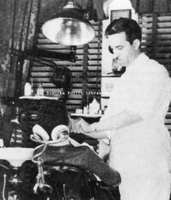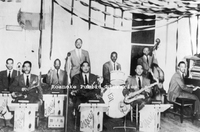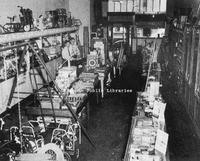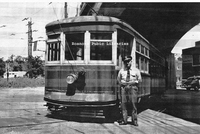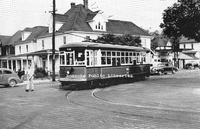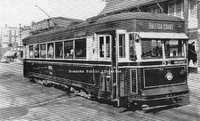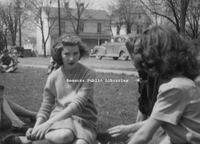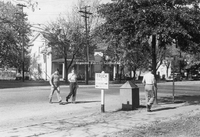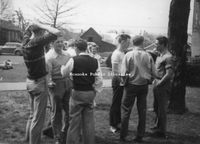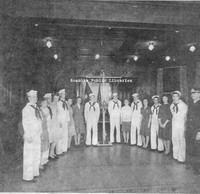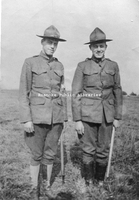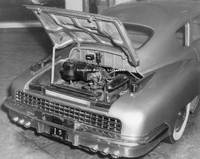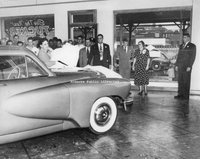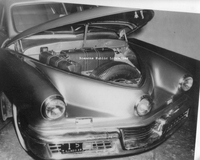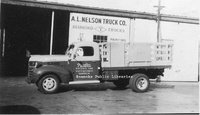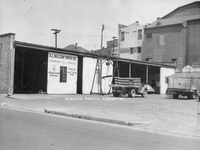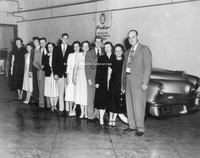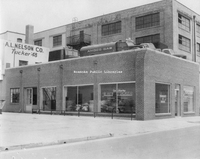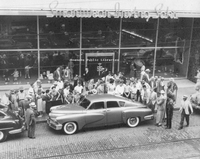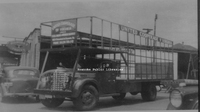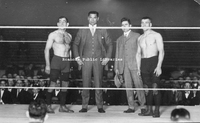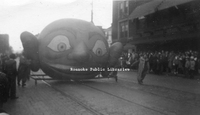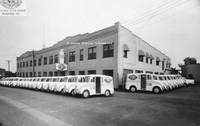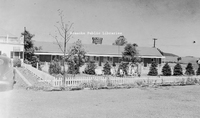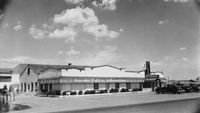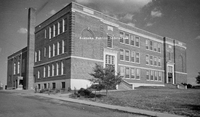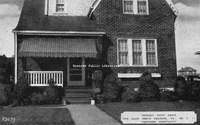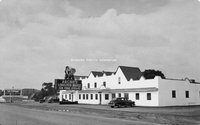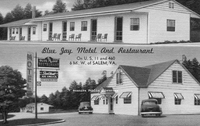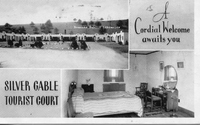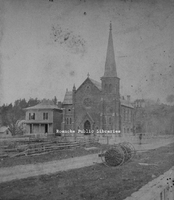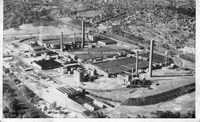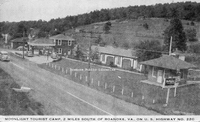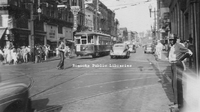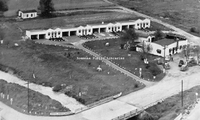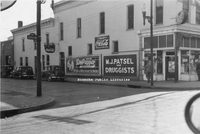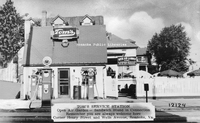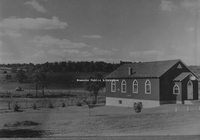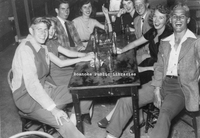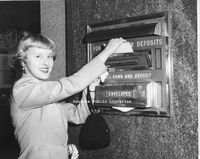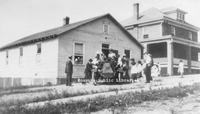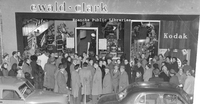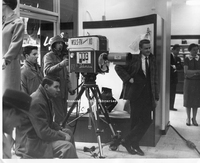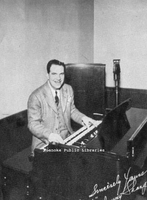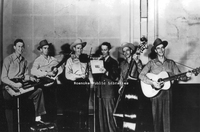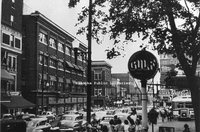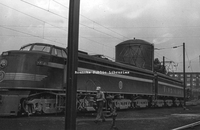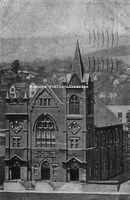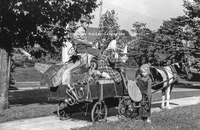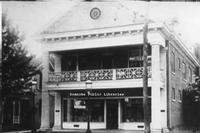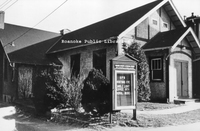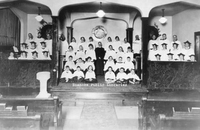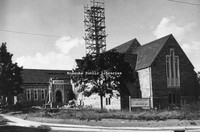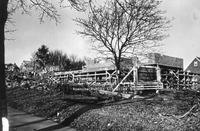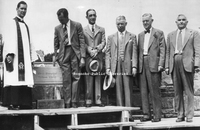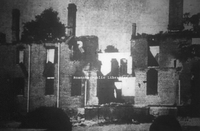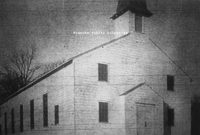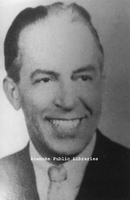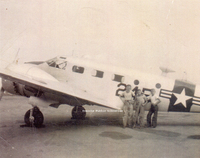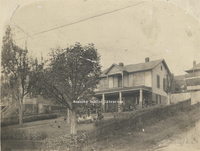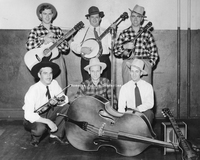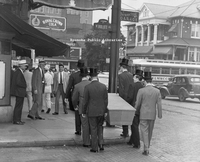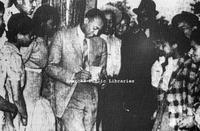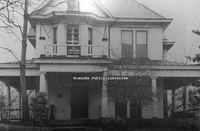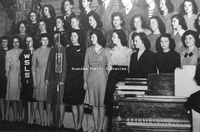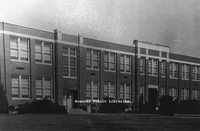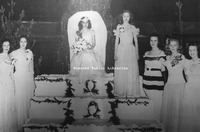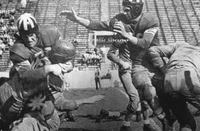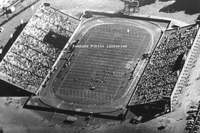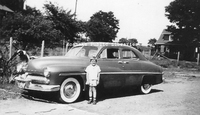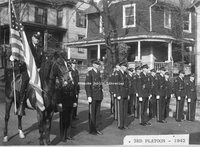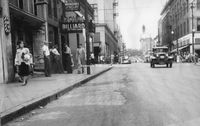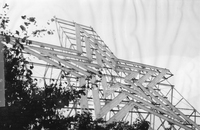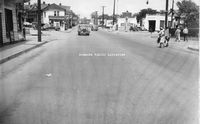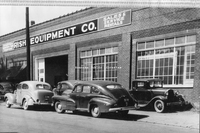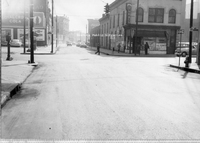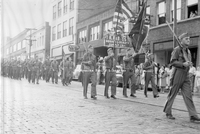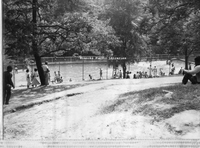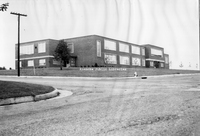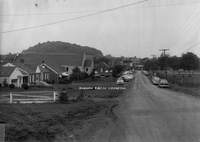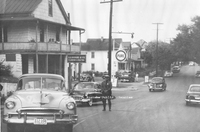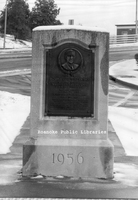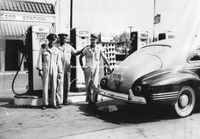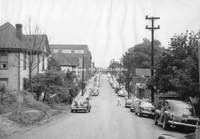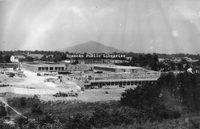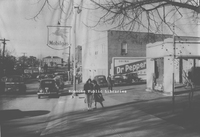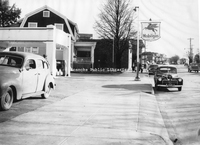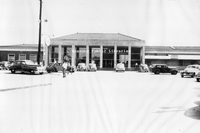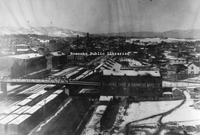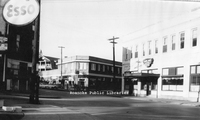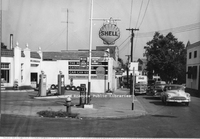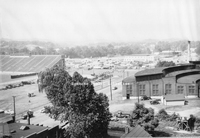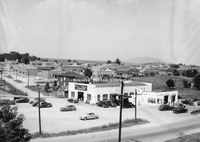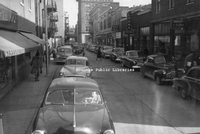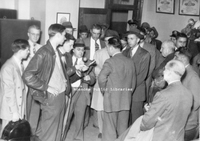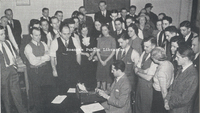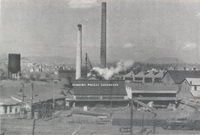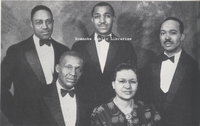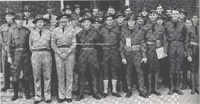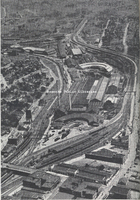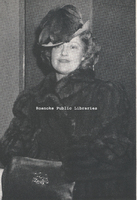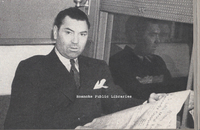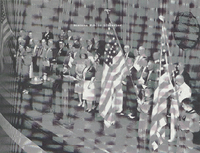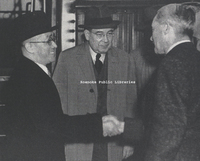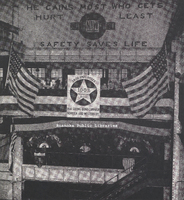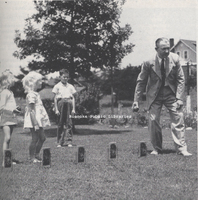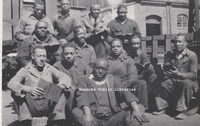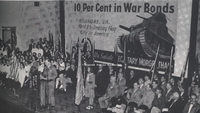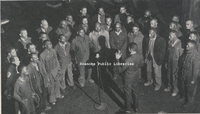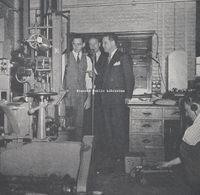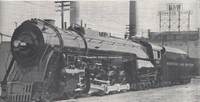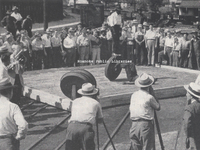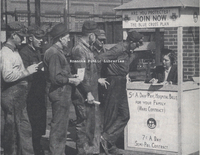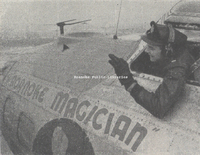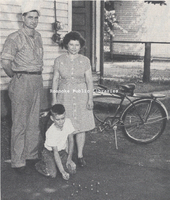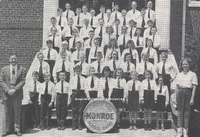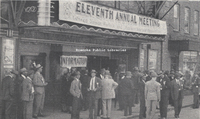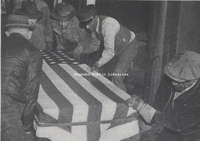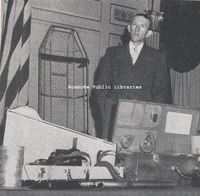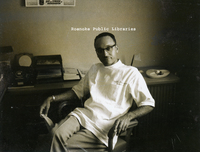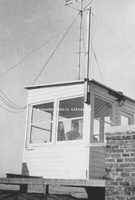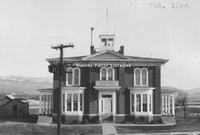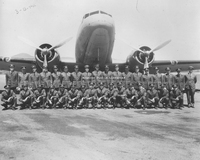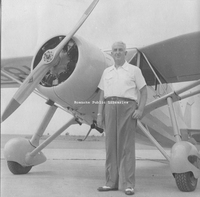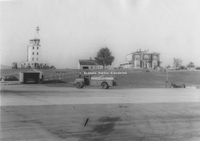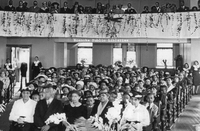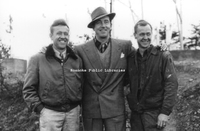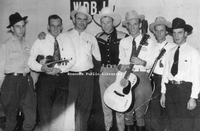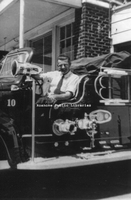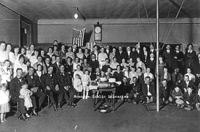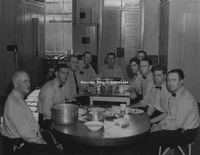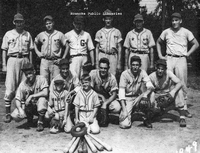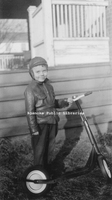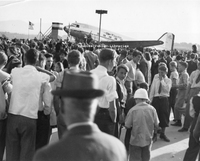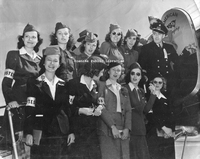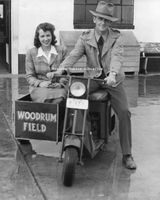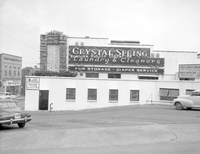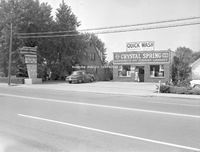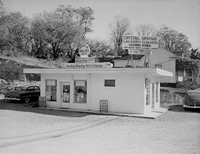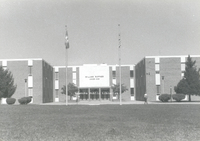Browse Items (6448 total)
SR085 The Boulevard
SR086 Broad Street
Tags: Broad Street, Salem
SR088 Courthouse
SR090 Courthouse
SR092 Baptist Orphanage
Tags: Baptist Orphanage, children's homes, orphanages, Salem
SR093 Baptist Orphanage
Tags: Baptist Orphanage, children's homes, orphanages, Salem
SR094 Baptist Orphanage
SR095 Baptist Orphanage
SR096 Baptist Orphanage
Tags: Baptist Orphanage, children's homes, orphanages, Salem
SR097 Baptist Orphanage
SR098 Baptist Orphanage
SR099 Baptist Orphanage
SR100 Baptist Orphanage
SR101 Baptist Orphanage
SR102 Lutheran Orphanage
SR104 Lutheran Orphanage
SR105 Women's Club
SR107 Monterey
Tags: Clay Street, High Street, houses, Monterey
SR108 Ridgewood Farm
Tags: houses, McVitty House, Ridgewood Farm, Salem
SR109 Strouse Home
Tags: Broad Street, Demetrius Strouse, houses, Salem, Strouse Home
SR110 N&W Passenger Station
SR111 N&W Passenger Station
SR112 N&W Passenger Station
SR113 N&W Passenger Station
SR114 Crawford Hotel
Tags: Crawford Hotel, hotels, Lucerne Hotel, Main Street, motels, Salem
SR115 Longwood
Tags: houses, Longwood, Salem Community Center
SR117 Fort Lewis
SR119 Salem
Tags: Salem
SR120 Mount Regis
SR121 Mount Regis
SR122 Salem High School
SR122 Salem High School
Tags: Broad Street, Salem, Salem High School, schools
SR124 Graded School A
Tags: Graded School A, schools, Water Street
SR126 G.W. Carver
SR127 Baptist Church
SR128 St. Pauls Episcopal
Tags: churches, Salem, St. Paul's Episcopal Church
SR130 Bethel Methodist Episcopal
SR131 Central Methodist
SR132 First Presbyterian
SR133 College Lutheran
SR134 Pentecostal Holiness
SR135 Methodist Episcopal South
SR136 Homestead Hotel
Tags: Homestead Hotel, hotels, motels, Old Globe Tavern, Route 11, Salem, taverns
SR137 Lake Spring
Tags: Lake Spring, Salem
SR144 Sherwood Burial Park
Tags: cemeteries, Salem, Sherwood Burial Park
SR145 Glass Plant
SR146 J.J. Newberry
Tags: J.J. Newberry Company, Salem, stores
SR147 Hotel Fort Lewis
Tags: Hotel Fort Lewis, Hotel Salem, hotels, motels, Salem
SR148 Post Office
SR149 Pierponts Brick Works
Tags: factories, Pierponts Brick Works, Salem
SR150 Andrew Lewis Monument
SR152 Municipal Field
Tags: baseball, Municipal Field, Salem
SR153 Salem Filtration Plant
Tags: Salem, Salem Filtration Plant
SR154 Salem Civic Center
Tags: arenas, Salem, Salem Civic Center
SR155 Farmers National Bank
Tags: banks, Farmers National Bank, Salem
SR162 Bittle Library
SR167 Roanoke College
Tags: colleges, Roanoke College, Salem, Smith Hall, universities
SR168 Roanoke College
Tags: colleges, Roanoke College, Salem, universities
SR170 Roanoke College
Tags: colleges, High Street, Roanoke College, Salem, universities
SR179 Parkway Motel
Tags: hotels, motels, Parkway Motel, Route 220
SR180 Memphis Special
Tags: locomotives, Memphis Special, N&W, Norfolk & Western, railroads, trains
SR183 Keister Home
Tags: hospitals, Keister Home Sanatorium
SR184 Scottie's Tavern
Tags: restaurants, Route 11, Scottie's Tavern, taverns
SR186 Martha Washington Candies
Tags: interiors, Martha Washington Candies, stores
SR187 Mountain Stroll
Tags: Mill Mountain
SR190 Bell Telephone
Tags: Bell Telephone Company
MP 60.1 Peaks of Otter Lodge
MP 60.2 Peaks of Otter Lodge
SHH004 Hara-Kiri Display
SHH007 Heironimus Float
Tags: Christmas, floats, Heironimus, parades
SHH020 McGregor Displays
SHH024 Heironimus Shoppers
FC001 Willis High School
Tags: Floyd County, schools, Willis, Willis High School
FC002 Mountain Normal School
Tags: Floyd County, Mountain Normal School, schools, Willis
FC003 Old Mountain Normal
Tags: Floyd County, Mountain Normal School, schools, Willis
FC008 Willis High School
Tags: Floyd County, schools, Willis, Willis High School
FC010 Willis Elementary School
FC011 Rollie Phillips Store
FC012 Floyd Esso
FC013 Mountain Normal School
Tags: Floyd County, Mountain Normal School, schools, students, Willis
FC014 Willis High School
Tags: Floyd County, schools, Willis, Willis High School
PGCC01 Piney Grove Christian Church
SF001 Church Avenue Bus Depot
Tags: buses, Church Avenue, Greyhound, Greyhound Bus Depot
HNWR002
HNWR003
Tags: depots, Montgomery County, N&W, Norfolk & Western, railroads, train stations, trains, Vicker
HNWR004
Tags: depots, N&W, Norfolk & Western, railroads, train stations, Welch, West Virginia
HNWR005
HNWR006
Tags: employees, Lynchburg, N&W, Norfolk & Western, railroads
HNWR007
HNWR008
Tags: mail cars, N&W, Norfolk & Western, Rail Post Office, railroads
HNWR009
Tags: accidents, James Cassell, N&W, Norfolk & Western, railroads, Thaxton, train wrecks, trains
HNWR010
Tags: locomotives, N&W, Norfolk & Western, railroads, steam engines, trains
HNWR011
HNWR012
Tags: Engine 500, locomotives, N&W, Norfolk & Western, Pocahontas, railroads, trains
HNWR013
Tags: N&W, Norfolk & Western, railroads, trains
HNWR014
HNWR016
HNWR019
Tags: Charlie Roby, employees, Engine 138, locomotives, N&W, Norfolk & Western, Radford, railroads, trains
HNWR020
Tags: employees, N&W, Norfolk & Western, trains
HNWR021
Tags: boxcars, N&W, Norfolk & Western, railroads, trains
HNWR022
Tags: cabooses, N&W, Norfolk & Western, trains
HNWR023
Tags: employees, N&W, Norfolk & Western, railroads
HNWR024
Tags: baggage cars, express cars, N&W, Norfolk & Western, trains
HNWR025
Tags: boxcars, N&W, Norfolk & Western, trains
HNWR026
HNWR030
Tags: Engine 1212, locomotives, N&W, Norfolk & Western, steam engines, trains
HNWR031
Tags: Engine 1442, locomotives, N&W, Norfolk & Western, roundhouses, trains
HNWR032
HNWR033
HNWR034
HNWR035
Tags: A.D. Lane, employees, Engine 345, Julian Hark, locomotives, N&W, Norfolk & Western, trains
HNWR036
Tags: auctions, farm trains, livestock, N&W, Norfolk & Western, trains
HNWR037
Tags: apprentices, employees, N&W, Norfolk & Western
HNWR038
Tags: employees, N&W, Norfolk & Western, railroads, tracks
HNWR039
Tags: employees, N&W, Norfolk & Western
HNWR040
Tags: employees, N&W, Norfolk & Western, upholsterers
HNWR041
Tags: B.I. Wade, C.G. Fridinger, E.F. Horgan, E.S. Kaetzel, Ed Roderick, Edgar Davis, Edward Irvin, employees, F.E. Fetterman, F.H. Wigmore, F.L. Pitzer, F.L. Zeone, Frank Bianchi, G.H. Hann, George Leisinger, H.H. Lawhorn, Ike Neff, J.F. Horton, J.L. McDonald, J.T. Withers, James Conway, John Griffin, John Smith, L.L. Hough, Louis Litsinger, Mike Fitzgerald, N&W, Norfolk & Western, Oren Ruefly, P.E. Lawhorn, Paul Wiegland, Pete Conway, Roanoke Boiler Shop, T.D Equi, T.J. Murray, Thomas Dugan, W.A. Kimmerling, W.D. Cassidy, W.E. Drabble, W.F. Dupree, W.G. Hardy, William Hough
HNWR042
HNWR043
HNWR044
HNWR045
HNWR046
Tags: cabooses, N&W, Norfolk & Western, trains
HNWR048
Tags: advertising, N&W, Norfolk & Western
HNWR049
Tags: depots, employees, N&W, Norfolk & Western, Schooler, train stations, W.H. Cord, W.H. Kegley
HNWR050
HNWR051
Tags: coal, Coal Pier 4, coal piers, Lambert's Point, N&W, Norfolk & Western
HNWR052
Tags: coal, coal piers, Lambert's Point, N&W, Norfolk & Western
HNWR053
Tags: coal, Coal Pier 4, coal piers, hoppers, Lambert's Point, N&W, Norfolk & Western
HNWR054
Tags: coal, employees, hoppers, N&W, Norfolk & Western
HNWR055
Tags: coal, coal tipples, hoppers, N&W, Norfolk & Western, trains
HNWR056
Tags: Class A, Engine 1200, locomotives, N&W, Norfolk & Western, trains
HNWR057
Tags: Class A, Engine 1200, locomotives, N&W, Norfolk & Western, trains
HNWR058
Tags: Class K, Engine 114, locomotives, N&W, Norfolk & Western, trains
HNWR059
Tags: Class K, Engine 118, locomotives, N&W, Norfolk & Western, trains
HNWR062
Tags: Class M, Engine 1112, locomotives, N&W, Norfolk & Western, trains
HNWR063
Tags: Class N, Engine 37, locomotives, N&W, Norfolk & Western, trains
HNWR064
Tags: Class U, Engine 76, locomotives, N&W, Norfolk & Western, trains
HNWR065
Tags: Class W, Engine 800, locomotives, N&W, Norfolk & Western, trains
HNWR066
Tags: Class Y, Engine 2023, locomotives, N&W, Norfolk & Western, trains
HNWR067
Tags: Class Y, Engine 2058, locomotives, N&W, Norfolk & Western, trains
HNWR068
Tags: Class Y, Engine 2087, locomotives, N&W, Norfolk & Western, trains
HNWR069
Tags: Class Y, Engine 2139, locomotives, N&W, Norfolk & Western, trains
HNWR071
Tags: Class Y, Engine 2200, locomotives, N&W, Norfolk & Western, trains
HNWR072
Tags: Class Z, Engine 1438, locomotives, N&W, Norfolk & Western, trains
HNWr073
HNWR074
HNWR075
Tags: floats, N&W, Norfolk & Western, parades, Union Local 440
HNWR076
HNWR077
Tags: employees, Engine 600, locomotives, N&W, Norfolk & Western, trains
HNWR078
Tags: N&W, Norfolk & Western, trains
HNWR079
Tags: ambulances, N&W, Norfolk & Western
HNWR080
HNWR081
Tags: employees, Henry Fink, N&W, Norfolk & Western
HNWR082
HNWR084
Tags: electric engines, Engine 2512, locomotives, N&W, Norfolk & Western, trains
HNWR085
Tags: diesel engines, Engine 1633, locomotives, N&W, Norfolk & Western, trains
HNWR086
Tags: diesel engines, Engine 8511, locomotives, N&W, Norfolk & Western, trains
HNWR087
Tags: diesel engines, Engine 1645, locomotives, N&W, Norfolk & Western, trains
HNWR088
HNWR089
Tags: Engine 20, locomotives, N&W, Norfolk & Western, trains
HNWR090
Tags: Class M, Engine 1100, locomotives, N&W, Norfolk & Western, trains
HNWR091
Tags: N&W, Norfolk & Western, snow
HNWR093
Tags: N&W, Norfolk & Western, Powhatan Arrow, trains
HNWR094
HNWR095
Tags: N&W, Norfolk & Western, passenger cars, Powhatan Arrow, trains
HNWR096
HNWR097
Tags: Engine 475, locomotives, N&W, Norfolk & Western, steam engines, trains
HNWR098
Tags: locomotives, N&W, Norfolk & Western, Pocahontas, Powhatan Arrow, trains
HNWR099
Tags: accidents, Engine 481, locomotives, N&W, Norfolk & Western, train wrecks, trains
HNWR100
Tags: accidents, Engine 43, locomotives, N&W, Norfolk & Western, Thaxton, train wrecks, trains
HNWR101
HNWR102
HNWR104
HNWR105
Tags: employees, N&W, Norfolk & Western
HNWR107
Tags: coal, Engine 53, locomotives, N&W, Norfolk & Western, trains
HNWR108
Tags: blacksmiths, employees, N&W, Norfolk & Western
HNWR109
Tags: Engine 173, locomotives, N&W, Norfolk & Western, Radford, Radford Pipe Yard, trains
HNWR110
HNWR111
Tags: diesel engines, Engine 1590, locomotives, N&W, Norfolk & Western, trains
HNWR112
HNWR113
HNWR114
HNWR115
HNWR116
Tags: Class A, Class J, Class Y, Engine 1203, Engine 2123, Engine 600, locomotives, N&W, Norfolk & Western, steam engines, trains
HNWR119
HNWR120
HNWR121
HNWR122
Tags: Christiansburg, depots, N&W, Norfolk & Western, train stations
HNWR123
Tags: depots, N&W, Norfolk & Western, soldiers, train stations, World War II
HNWR124
HNWR125
Tags: erecting shops, locomotives, N&W, Norfolk & Western, trains
HNWR126
HNWR127
HNWR128
HNWR129
HNWR131
HNWR133
HNWR134
Tags: dynamometers, N&W, Norfolk & Western, trains
HNWR135
Tags: mail cars, N&W, Norfolk & Western, trains
HNWR136
HNWR137
Tags: freight docks, Lambert's Point, N&W, Norfolk & Western
HNWR138
HNWR139
HNWR140
Tags: coal yards, locomotives, N&W, Norfolk & Western, trains
HNWR141
HNWR142
Tags: depots, Grundy, N&W, Norfolk & Western, train stations
HNWR143
HNWR144
HNWR145
HNWR146
Tags: coal, employees, Kimball West Virginia, N&W, Norfolk & Western, yardmen
HNWR147
Tags: employees, freight stations, N&W, Norfolk & Western
HNWR148
HNWR149
Tags: employees, Engine 264, locomotives, N&W, Norfolk & Western, steam engines, trains
HNWR150
HNWR151
HNWR152
HNWR153
Tags: Bellevue Yard, N&W, Norfolk & Western, railroads, railyards
HNWR154
HNWR155
Tags: depots, N&W, Norfolk & Western, Salem, train stations
HNWR158
HNWR159
HNWR160
Tags: employees, N&W, Norfolk & Western, railroads
HNWR161
HNWR162
Tags: coal, coal mines, freight cars, Gary West Virginia, N&W, Norfolk & Western, trains
HNWR163
Tags: coal, freight cars, N&W, Norfolk & Western, Portsmouth Ohio
HNWR164
Tags: Bluefield Yard, N&W, Norfolk & Western, railyards
HNWR165
HNWR166
Tags: Class W, Engine 839, locomotives, N&W, Norfolk & Western, steam engines, trains
HNWR167
HNWR168
HNWR170
HNWR172
HNWR173
HNWR174
HNWR175
HNWR176
HNWR177
Tags: freight cars, locomotives, N&W, Norfolk & Western, trains
HNWR178
Tags: express cars, freight cars, N&W, Norfolk & Western, trains
HNWR179
HNWR180
HNWR182
HNWR183
HNWR184
Tags: cargo ships, coal, Lambert's Point, N&W, Norfolk & Western
HNWR185
Tags: cargo ships, coal, coal cars, freight cars, N&W, Norfolk & Western, SS Carl Fritzen
HNWR186
Tags: cargo ships, coal, coal piers, N&W, Norfolk & Western
HNWR187
HNWR188
Tags: Frederick J. Kimball
HNWR192
HNWR193
Tags: Engine 131, hoists, locomotives, N&W, Norfolk & Western, railyards, trains
HNWR194
HNWR195
HNWR196
Tags: coal, Engine 2146, freight cars, locomotives, N&W, Norfolk & Western, steam engines, trains
HNWR197
Tags: coal, coal hoppers, freight cars, N&W, Norfolk & Western, railyards
HNWR198
HNWR199
Tags: coal, coal hoppers, coal tipples, freight cars, N&W, Norfolk & Western
HNWR202
Tags: locomotives, N&W, Norfolk & Western, steam engines, trains
BM382
RNRV1 Appalachian Power
RNRV2 McAfee Knob
Tags: Appalachian Trail, McAfee Knob
RNRV4 Paul Davis
Tags: Paul Davis, Pauline Davis, soldiers, World War I, WWI
RNRV5 Davis Children
Tags: Edith Davis, Frangie Davis, horses, Paul Davis
RNRV6 Davis Men
RNRV8 Paine Family
RNRV10 Davis Family
Tags: John Gibson Davis, Zora Davis
RNRV13 VFW Banquet
RNRV14 Vest Furniture
RNRV15 Confederate Veterans
Tags: Confederate Veterans, confederates, horses, parades
RNRV16 Confederate Veterans
Tags: Confederate Veterans, confederates, parades
RNRV17 Confederate Veterans
Tags: Confederate Veterans, confederates, floats, parades
RNRV19 Mountain Park
RNRV21 Market Street
Tags: farmers, Fenton Furniture Company, Market Street, oxen, wagons
RNRV22 Mountain Park
RNRV23 Views
Tags: Tinker Mountain, views
RNRV25 Country Drive
Tags: automobiles, cars, Mitchell Automobiles
RNRV28 Steele Family
Tags: Alma Steele, Carl Steele, John Steele
RNRV30 Beckner Family
RNRV31 W.J. Rigney
RNRV32 Mountain Park
RNRV33 Crystal Spring
RNRV34 High Street Baptist
RNRV37 Roanoke Ice
Tags: Roanoke Ice Corporation
RNRV41 N&W Employees
Tags: employees, N&W, Norfolk & Western
RNRV45 Campbell and Jefferson
RNRV46 Blackwell Grocery
RNRV48 Police Officers
RNRV49 Burrell Memorial
RNRV50 Campbell Avenue
Tags: Campbell Avenue, streetcars, Terry Building
RNRV51 Henry McGuire
Tags: Henry McGuire, J.L. Dishong, wagons
RNRV52 Daughters of Liberty
Tags: Daughters of Liberty, floats
RVNH4001 Junior Grocery
Tags: Franklin Road, Junior Grocery
RVNH4002 Junior Grocery
Tags: Franklin Road, Junior Grocery
RVNH4003 JP Sandlot Football Team
Tags: football teams, Jackson Park, Sam Elliott, sports
RVNH4004 Young Men
Tags: 14th Street, portraits, Roy Minnix
RVNH4005 Kiddie Pool
Tags: Roy Minnix, Southeast
RVNH4006 Southeast
Tags: Jamison School, Southeast
RVNH4008 Wanderers of the Wasteland
RVNH4009 Forbes-Hodges Reunion
Tags: Forbes Family, Hodges Family, reunions, Wirtz
RVNH4020 American Viscose
Tags: American Viscose, factories, mills
RVNH4021 American Viscose
Tags: American Viscose, factories, mills
RVNH4022 American Viscose
Tags: American Viscose, factories, mills
RVNH4023 Hillcrest House
Tags: American Viscose, dormitories, factories, Hillcrest House, mills
RVNH4024 Yellow Cab
RVNH4026 Mason-Dixon Airlines
RVNH4027 CAA Tower
RVNH4028 CAA Tower
RVNH4029 Woodrum Field
Tags: airplanes, airports, Tinker Mountain, Woodrum Field
RVNH4031 Sikorsky
Tags: airports, helicopters, Sikorsky, Woodrum Field
RVNH4032 Crash Truck
Tags: airports, Cadillacs, crash trucks, Woodrum Field
RVNH4034 Woodrum Field
Tags: airports, construction, Woodrum Field
RVNH4036 Woodrum Field
Tags: aerial views, airports, Woodrum Field
RVNH4042 Frantz Flying Service
RVNH4043 Navy Pilot Cadets
Tags: airplanes, airports, Douglas C-47, Navy, pilots, Woodrum Field
RVNH4046 Johnny Non-Voter
RVNH4047 Eddie Rickenbacker
RVNH40113 Rev. William Simmons
RVNH40115 Smartwear Irving-Saks
RVNH40116 Jefferson Street
Tags: floods, Jefferson Street, Roanoke City Mills
RVNH40117 Community Drug Store
RVNH40118 Community Drug Store
RVNH40119 Dr. Harry Penn
Tags: dentists, Dr. Harry Penn, Henry Street
RVNH40120 The Aristocrats
RVNH40121 Jennings-Shepherd
RVNH40122 Homer Turner
RVNH40123 Car 42
Tags: 9th Street, Car 42, Jamison Avenue, Southeast, streetcars, trolleys
RVNH40125 Car 52
Tags: Car 52, Grandin Road, Raleigh Court, streetcars, trolleys, Westover Avenue
RVNH40148 David McClung
RVNH40149 Mary Brand
RVNH40150 College and Fourth
RVNH40151 ALHS Students
RVNH40152 Sea Scouts
RVNH40153 Ralph Baker & Joe Hunter
Tags: France, Joe Hunter, Ralph Koiner Baker, World War I
RVNH40186 Tucker 48
Tags: A.L. Nelson Company, automobiles, cars, Tucker 48
RVNH40187 Tucker 48
RVNH40188 Tucker 48
Tags: A.L. Nelson Company, automobiles, cars, Tucker 48
RVNH40189 A.L. Nelson Truck Company
RVNH40190 A.L. Nelson Truck Company
RVNH40193 A.L. Nelson Company
RVNH40194 A.L. Nelson Company
RVNH40195 Tucker 48
Tags: automobiles, cars, Downtown, Smartwear Irving-Saks, Tucker 48
RVNH40196 United Cooperage Truck
RVNH40197 Jack Dempsey
Tags: Jack Dempsey, Roanoke Auditorium, wrestlers
RVNH40198 Roanoke Parade
Tags: balloons, Christmas parade, Downtown, floats, Jefferson Street, parades
RVNH40200 Garst Brothers Dairy
Tags: dairies, Garst Brothers Dairy, Salem Avenue
RVNH40201 Plaza Tourist Court
Tags: hotels, motels, Plaza Tourist Court, Williamson Road
RVNH40203 Plaza Restaurant
RVNH40204 Lucy Addison High
RVNH40206 Friendly Guest House
RVNH40207 Archie's Lobster House
RVNH40208 Blue Jay Motel
Tags: Blue Jay Motel, Blue Jay Restaurant, hotels, motels, restaurants, Route 11
RVNH40210 Silver Gable
Tags: hotels, motels, Route 11, Silver Gable Tourist Court
RVNH40212 American Viscose
RVNH40213 Moonlight Tourist Camp
Tags: hotels, Moonlight Tourist Camp, motels, Route 220
RVNH40214 Campbell Avenue
RVNH40216 Hollins Inn
Tags: Hollins Inn, Hollins Inn Tourist Court, hotels, motels, Route 11
RVNH40218 MJ Patsel Druggists
RVNH40218 Tom's Service Station
RVNH40220 Little River Baptist
RVNH40222 Coffee Pot
Tags: bars, Bob Nelson, Brambleton Avenue, Coffee Pot, Dick Nelson, restaurants
RVNH40223 Appalachian Power
RVNH40227 Virginia Heights Baptist
RVNH40228 Virginia Heights Baptist
RVNH40240 Ewald-Clark
Tags: Church Avenue, Downtown, Ewald-Clark, photographers
RVNH20246 WSLS TV
RVNH40248 Orange Blossom Boys
RVNH40249 Jefferson Street
RVNH40250 Virginian Railway
RVNH40251 High Street Baptist
RVNH40253 Scrap Drive
Tags: World War II
RVNH40257 Tinnell's
RVNH40258 Virginia Heights Lutheran
RVNH40259 Virginia Heights Lutheran
RVNH40260 Christ Lutheran
RVNH40262 Christ Lutheran
RVNH40263 Christ Lutheran
RVNH40264 Christ Lutheran
RVNH40268 Our Lady of Perpetual Help
RVNH40269 Dr. Harry Penn
Tags: dentists, Dr. Harry Penn
RVNH40274 Military Aircraft
RVNH40275 Schley Home
RVNH40276 Blue Ridge Entertainers
RVNH40277 Johnny Non-Voter
RVNH40279 Jesse Owens
Tags: athletes, Carver School, Jesse Owens, Olympians
RVNH40280 Viaud School
Tags: Mountain Avenue, Old Southwest, schools, Viaud School
RVNH40282 William Fleming High
RVNH40283 Snow Queen
RVNH40284 Jefferson vs. Byrd
RVNH40287 Victory Stadium
RVNH40288 Eddie Bennett
Tags: 30th Street, automobiles, cars, Eddie Bennett, Mercury
RVNH40291 Roanoke Police Department
RVNH40294 Gilmer Avenue
RVNH40295 Rish Equipment
RVNH40296 Salem Avenue
RVNH40297 Parade
Tags: 3rd Street, Campbell Avenue, Downtown, parades, soldiers
RVNH40300 Monroe Junior High
RVNH40301 Fleming Avenue
Tags: Fleming Avenue, Winsloe Avenue
RVNH40302 Tazewell Avenue
Tags: 3rd Street, Southeast, Tazewell Avenue
RVNH40303 Hunter Memorial
Tags: memorials, monuments, W.P. Hunter Memorial
RVNH40305 6th Street
Tags: 6th Street, Marshall Avenue, Old Southwest
RVNH40306 Lucy Addison High
RVNH40310 Henry Street Bridge
RVNH40311 Franklin Road
RVNH40312 Franklin Road
Tags: Downtown, Elm Avenue, Franklin Road, gas stations, service stations, Shell
RVNH40313 Reserve Avenue
RVNH40314 Lansdowne
RVNH40316 Detective Interview
RVNH40404 Robertson Singers
RVNH40405 Gun Club
Tags: J.J. Barry, Roanoke Gun Club
RVNH40406 116th Infantry
Tags: 116th Infantry, 23rd Battalion, Marines, N&W, Norfolk & Western
RVNH40407 N&W Shops
RVNH40409 Jack Dempsey
Tags: Jack Dempsey
RVNH40410 Bethel & Starkey Choirs
RVNH40411 N&W Veterans
RVNH40412 Dr. Hu Shih
Tags: Dr. Hu Shih, George Dunglinson, J.S. Easley
RVNH40414 War Bond Rally
Tags: N&W, Norfolk & Western, war bonds
RVNH40415 USO Lounge
RVNH40416 Sok-a-Blok
Tags: games, Sok-a-Blok, toys, W.C. Driscoll
RVNH40417 Noon-Day Chorus
RVNH40418 Henry Morgenthau Jr.
RVNH40419 N&W Male Chorus
Tags: choruses, N&W, Norfolk & Western Male Chorus, singers
RVNH40420 N&W Radio Production
Tags: Ed Skotch, J.L. Ramsey, N&W, Norfolk & Western, Phillips Briggs, Tom Slater, WSLS
RVNH40421 Engine 605
RVNH40422 Wheel Rollers
RVNH40423 Blue Cross
Tags: Blue Cross, employees, N&W, Norfolk & Western
RVNH40424 E.H. St. Clair
RVNH40425 Roanoke All-Stars
RVNH40426 Larry Vinson
Tags: Earl O. Vinson, Larry Vinson
RVNH40427 Monroe Junior Band
RVNH40428 N&W Veterans
RVNH40429 James Pullen
RVNH40431 Roanoke Cardinals
RVNH40432 Julian Wise
RVNH40433 N&W Band
RVNH40453 Control Tower
RVNH40454 Cannaday House
RVNH40458 Clifton Woodrum
RVNH40459 Woodrum Field
RVNH40500 Mt. Zion AME
RVNH40501 John Payne
Tags: Bob Kinsey, John Payne, Roy Kinsey Jr.
RVNH40518 Roy Hall
RVNH40519 Lester Kelly
RVNH40520 Fire Station 1
RVNH40521 Fire Station 1
RVNH40526 Starkey Baseball
RAC78 Woodrum Field Dedication
RAC79 Woodrum Field Dedication
Tags: airports, American Airlines, Claudine Pendleton, Dot Donahoe, Evelyn Correll, Jean Fishburn, Jessie Mae Jones, Louise Frantz, Mae Williams, Marion Elliott, Marjorie Moore, Martha Woodrum, Onita Hylton, planes, Roanoke Municipal Airport, Roanoke Regional Airport, Roanoke-Blacksburg Regional Airport, Woodrum Field
RAC80 Woodrum & Donahoe
Tags: Bob Donahoe, Martha Woodrum, Woodrum Field
MP 50.1 Crystal Spring Laundry
MP 50.2 Crystal Spring Laundry
MP 50.3 Crystal Spring Laundry
Tags: Crystal Spring Laundry, Main Street, Salem
